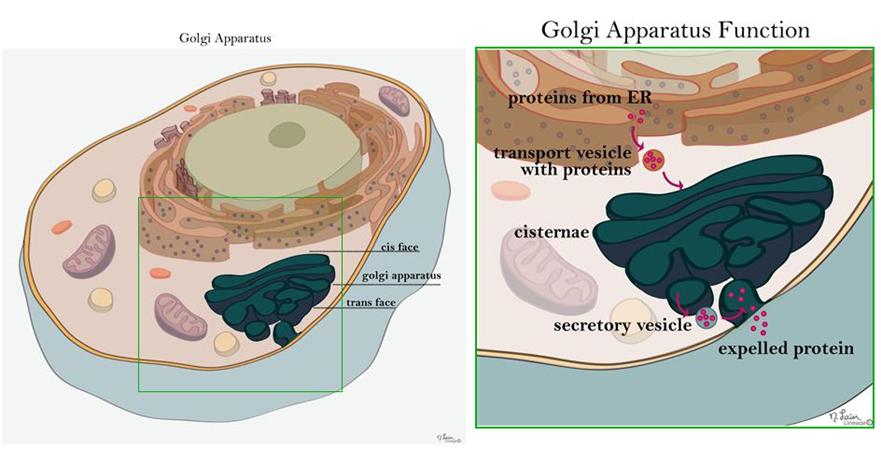
Introduction
The Golgi apparatus, also known as the Golgi complex or Golgi body, is a complex organelle found in eukaryotic cells. It was named after its discoverer, Italian biologist Camillo Golgi, who first observed the structure in the late 19th century.
The Golgi apparatus is responsible for the processing, sorting, and modification of proteins and lipids that are synthesized in the endoplasmic reticulum (ER). It is composed of a stack of flattened membrane-bound sacs called cisternae, which are organized in a series of distinct regions or compartments.
Structure
- Stacks of cisternae
- Associated with membrane-bound vesicles
- Two faces
- cis
- receiving face from the ER
- input to the Golgi
- convex shape
- trans
- exports away from Golgi
- location of trans-Golgi network
- faces plasma membrane
- concave shape
- cis
Function
- Post-translational peptide modification
- addition of
- cleavage of propeptides
- peptidase cleaves proinsulin to insulin + C-peptide
- deficient in hyperproinsulinemia
- presents similar to NIDDM
- deficient in hyperproinsulinemia
- peptidase cleaves proinsulin to insulin + C-peptide
- Packaging/distribution of proteins and lipids
- received from ER (adds amino acid residues that golgi later modifies)
- via coat protein complex (COP) II
- this protein initiates budding process
- RER→ cis-Golgi = anterograde
- anterograde movement mediated by COP II
- Golgi → ER = retrograde
- retrograde movement mediated by COP I
- via coat protein complex (COP) II
- leaves Golgi headed towards several destinations
- plasma membrane
- lysosomes
- secretory vesicles
- mediated by clathrin
- received from ER (adds amino acid residues that golgi later modifies)
- Proteoglycan assembly
- sulfation of sugars
Types
There is only one type of Golgi apparatus, which is found in all eukaryotic cells. However, the Golgi apparatus can be categorized into two types based on its morphology and location within the cell: the cis-Golgi and the trans-Golgi.
The cis-Golgi, also known as the entry face, is located near the endoplasmic reticulum (ER) and receives newly synthesized proteins and lipids from the ER for further processing and modification.
The trans-Golgi, also known as the exit face, is located at the opposite end of the Golgi stack and is responsible for sorting and packaging the processed proteins and lipids into vesicles for transport to different parts of the cell or for secretion outside the cell.
In addition to these two types of Golgi, there is also a third type called the medial-Golgi, which is located between the cis- and trans-Golgi regions and is involved in further processing and modification of the proteins and lipids.
Studies
The Golgi apparatus has been the subject of numerous studies over the years, as it plays a critical role in several important cellular processes. Some of the key areas of research related to the Golgi apparatus include:
- Golgi structure and organization: Researchers have investigated the structure and organization of the Golgi apparatus, including the number of cisternae in the Golgi stack, the mechanisms that control Golgi assembly and disassembly, and the proteins and enzymes that are localized to different regions of the Golgi.
- Golgi function and regulation: Researchers have explored the role of the Golgi in protein and lipid modification, sorting, and packaging, as well as the mechanisms that regulate these processes. This includes the identification of specific enzymes and transporters that are critical for Golgi function, as well as the signaling pathways that control Golgi activity.
- Golgi-related diseases: Several diseases have been linked to abnormalities in the Golgi apparatus, including some types of cancer, neurological disorders, and genetic disorders affecting protein glycosylation. Researchers have studied these diseases to better understand the underlying cellular and molecular mechanisms and to develop new treatments.
- Golgi evolution and diversity: Researchers have investigated the evolution and diversity of the Golgi apparatus across different organisms, including the emergence of different Golgi types and the mechanisms that drive Golgi evolution and adaptation.
Overall, studies of the Golgi apparatus have provided important insights into the cellular processes that underlie many aspects of cell function and human health.
Complications
The Golgi apparatus is a critical organelle in eukaryotic cells, and its proper functioning is essential for many cellular processes. As a result, defects or dysfunctions of the Golgi apparatus can lead to various complications. Some of the most common Golgi-related complications include:
- Protein trafficking disorders: The Golgi apparatus plays a key role in the sorting and packaging of proteins for transport to different parts of the cell or for secretion outside the cell. Dysfunctions in the Golgi can lead to defects in protein trafficking, which can cause a wide range of diseases, including some types of cancer, neurological disorders, and genetic disorders affecting protein glycosylation.
- Lysosomal storage disorders: The Golgi apparatus is also involved in the formation of lysosomes, which are specialized organelles that contain enzymes used to break down cellular waste and foreign substances. Dysfunctions in the Golgi can lead to defects in lysosomal enzyme trafficking, which can cause lysosomal storage disorders, such as Tay-Sachs disease and Gaucher disease.
- Polysaccharide synthesis disorders: The Golgi apparatus is involved in the synthesis of certain complex polysaccharides. Defects in Golgi function can lead to abnormalities in polysaccharide synthesis, which can cause various disorders, including some types of muscular dystrophy.
- Viral infections: Several viruses have been shown to target the Golgi apparatus as part of their replication cycle. Infection of the Golgi can disrupt its normal functioning, leading to cellular damage and disease.
Overall, complications of the Golgi apparatus can have wide-ranging effects on cellular and organismal health, and understanding the underlying mechanisms of these complications is an important area of research for both basic science and clinical applications.
Check out Interview Preparation, CV and Personal Statement Editing – The Finale.



